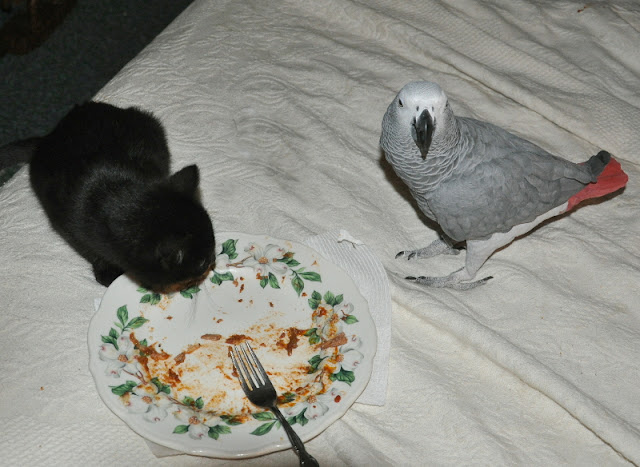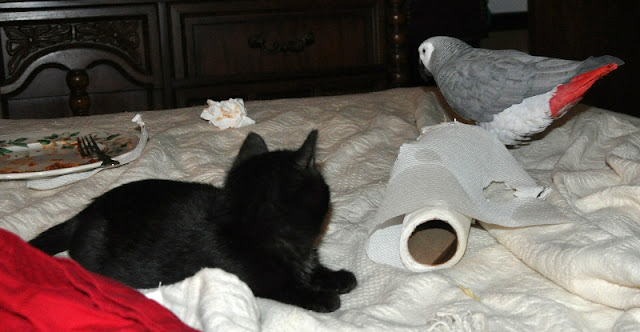This is Quicksilver the African Grey deciding to go over on the bed near Cardiac the Stray Kitten. Note the feathers standing up. Note Cardiac's focus.
Cardiac made a slight jerk forward. Quicksilver made an almost simultaneous slight jerk forward in response. Cardiac desisted and to prove who was boss, Silver strutted behind her with his feathers puffed out looking LARGE.
Silver gambols back and they stare at each other. As you see, Cardiac is smaller than Silver, which won't be the case for long. Currently he could take her nose off, if she jumped him. She only has milk teeth and her nails though needle like wouldn't do much damage but as they could be coated with the bacteria from her mouth which can cause deadly infections in avian species, we want to develop a kind of no touching mutual respect between the two.
Interestingly Silver did not resort to his usual trick which he uses to cow grown cats. He walks up to them (flying would set off their hunting reflex) and makes a long drawn out angry meow an inch from their faces. The cats look both horrified and completely confused. They retreat to go think about it. Works every time.
Having given Cardiac the first lesson in parrot/kitten detente manners, Silver looks at me and says calmly, "Want up."
I put him on top of his cage where he helps himself to some Nutri-berries.
Being a kitten, Cardiac hasn't much of an attention span for nothing happening. She therefore rolls over and waggles her paws at me. Which as she's exposed her genitals, we'll talk about the conflicting sexing of this kitten. Given two kittens of opposite sexes, I can sex them. When faced with a single kitten I don't feel completely competent. Therefore I asked a former farm girl who said that she was female. I then asked a former Humane Society worker who pronounced her male-- then a former farm boy, who said female. I myself am leaning toward female. She goes to the vet for her first visit tomorrow for the final proclamation.
In the meantime, here is a overexposed and enlarged picture of the area in question. Any kitten sexing mavins out there?
Why is kitten named Cardiac?
At times the white spot on her chest can look rather like a heart. And naming her Cupid just seemed completely vapid.
Of course the spot can also look like a fancy chicken- beak left, or alternately a running sheepdog who has just bitten through an electrical cord.
I'm still somewhat open to suggestions.
Back to our inter-species situation--I'd left the room to go eat some lunch and was just picking up my plate to take it to the sink when I heard something fall to the floor in the bedroom. I rushed in, plate and all.
Silver was standing on the dresser having just shoved a bottle of hand lotion off the edge. Cardiac was no where to be seen. My hope was Silver hadn't beaned her with the bottle. (Some of you will remember him sliding a drinking glass off the kitchen counter as an aerial bombardment aimed at Chekhov the Cat.) I sat the plate down on the bed and started looking. Under the bed, no. In the bathroom, no...back to the bedroom...
What should I find but Cardiac and Silver in a stand-off over the remnants of my lunch. Note Silver's expression.
Silver is now giving the cat one of his specie's "slitty eyed looks" which usually mean he's about to get aggressive. He's bullied many a person out of their kornkurls at lunch with that look. It is not working on kitten, though she is keeping an eye on him.
Horrified he watches Cardiac's tongue progress across the plate.
Silver walks over with purpose, crowds the camera, and says,"Mine!" We have a small discussion about shoving things off of furniture.
He isn't impressed and goes for a roll of paper towels on the other side of the bed and begins to tear them up with his beak. An episode of misplaced aggression.
Silver really would like to bite the kitten (or me) but he's been told she's a baby and in his favor when she cries, he does repeat in a very sweet voice, "It's okay. It's okay."
But that was before she appropriated the lunch plate.
Then it happens!
The activity has attracted the cat away from the plate.
Silver walks up close to me again.
Silver then walks away and the kitten has begun to play.
And Silver walks back over to me and says, "Want up".
What actually went on here?
Donegal Browne




























